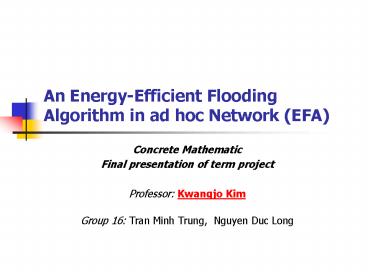An Energy-Efficient Flooding Algorithm in ad hoc Network (EFA) - PowerPoint PPT Presentation
Title:
An Energy-Efficient Flooding Algorithm in ad hoc Network (EFA)
Description:
An Energy-Efficient Flooding Algorithm in ad hoc Network (EFA) Concrete Mathematic Final presentation of term project Professor: Kwangjo Kim Group 16: Tran Minh Trung ... – PowerPoint PPT presentation
Number of Views:105
Avg rating:3.0/5.0
Title: An Energy-Efficient Flooding Algorithm in ad hoc Network (EFA)
1
An Energy-Efficient Flooding Algorithm in ad hoc
Network (EFA)
- Concrete Mathematic
- Final presentation of term project
- Professor Kwangjo Kim
- Group 16 Tran Minh Trung, Nguyen Duc Long
2
An Energy-Efficient Flooding Algorithm in Ad-Hoc
Network (EFA)
- Related Works
- Problem statement
- Proposed Solution
- Simulation Evaluation
3
Related Works
- Related work (Previous paper PAODV, APRA, MMBCR)
- Congested node, Week node Reject or relay the
coming connection -gt Reduce the network
connectivity - Single path from source to destination Slow
transmission speed, Increase control packet over
head -gt Waste energy
Proposed solution
- Disjoint a single path in to multiple paths
(dependent on energy capacity of each sub path) - Balance the power consumption between Strong node
and week node -gt reduce the partition problem (1) - Increase Network Connectivity -gt Reduce routing
discovery phase (2) - 1,2 -gt Increase Network life time
4
Problem statement (1)
Run Routing discovery phase again many times
-gt Waste time Energy consuming
Run Routing discovery phase fewer time -gt Save
time, Energy
5
Problem statement (2)
- Ad Hoc model
- Directed Graph G(V, E) where V is the set of all
nodes and E is the set of all directed links (i,
j) where i, j ? V. - Ni Set of all neighbors nodes of node (i)
(i)
(j)
- Directed graph G(V,E)
- Weighted link E(i,j)
- Set of neighbor node N(i)
6
Problem statement (2)
- Node (i)
- Energy available
- In case of serving j node at the same time
- Otherwise
f(i,k)
f(j,i)
i
e(i) er(i) - erq(i)
?f(j,i) ?f(i,k)
e(i) er(i)
7
Problem statement (3)
e(2)40
- Directed link (i,j)
- exist if and only if J ? Ni
- Energy capacity of link (i,j)
- Life time of a routing path Life time of each
link or each node
e(1)10
Source
Dest.
e(5)10
e(i,j) Min (e(i),e(j))
e(3)60
e(4)40
Link 1 e(sd) Min (e(3),e(4))40 Link 2 e(sd)
Min (e(1),e(2))10
8
RREQ Flooding method
9
Lexicographic order
- A routing path will be chosen dependent on 3
information - Fresh sequence number F(i)
- Min Energy capacity E(i)
- Hop count to destination H(i)
- The path will be selected dependent on
lexicographic order - Path i (F(i), E(i), H(i))
- The number of path is dependent on the total
energy requirement, and the energy available of
all possible paths
10
The mesh network example (1)
Eliminated because of containing weaker node
X
Eliminated because of backward flooding
(Increase hop count)
X
X
11
The mesh network example (2)
12
Simulation Evaluation(1)
- Simulation model
- 10 - 50 mobile nodes
- are generated randomly in an area of 500M500M.
- The moving speed of each node is 5m/s.
- 2-20 connections is established during 900
seconds simulation times. - The energy model
- initial energy of each node is 20mW.
- The energy usage for receiving and sending each
packet are txPower 0.6mW and rxPower 0.3mW
respectively.
13
Simulation Evaluation(2)
Routing overhead (control messages)
Expiration sequences of nodes
14
Simulation Evaluation(3)
Route reliability
End to End Delay
15
Conclusion (1)
- Final achievement
- Use concrete mathematic knowledge for writing
higher quality paper - Graph theory
- Directed graph
- Weighted link
- Lexicographic Order
- Set theory
- Experiences in dealing with NS2, Perl, gnuplot
16
Conclusion (2)
- Contribution
- Proposed new Energy-Efficient Flooding Algorithm
for Ad-Hoc routing protocol - Simulation results shows betters performance
- Future plan
- Complete full paper (With more different
complicated scenarios mobility measurement) - After getting review advice from Profesor -gt
submit to international conference - Apply some Stochastic and Mathematical model -gt
Journal paper
17
Progress after midterm report
- Writing simulation program by NS2 ( Tran Minh
Trung) - Generate scenarios by TCL script
- Apply energy model to standard scenarios
- Write simulation results to log files
- Analisys simulation log files ( Nguyen Duc Long)
- Write perl modules (Collect Split data)
- Write drawing script by gnuplot (linux)
18
Reference
- Paper
- T.M Trung, S.-L. Kim, An Adaptive Power Aware
Routing Algorithm for Ad Hoc Networks, Submitted
to ICWC Toronto Canada 2003 - H.X.Tung, T.M Trung, V.D Liem, P.V Su, Power
Aware Ad-Hoc Ondemand Distance Vector Routing
Protocol, KISA 2003 - Charles E. Perkins, Elizabeth M. Belding-Royer,
and Samir Das. "Ad Hoc On Demand Distance Vector
(AODV) Routing." IETF Internet draft,
draft-ietf-manet-aodv-10.txt, March 2002 (Work in
Progress). - C.-K. Toh, H. Cobb, and D.A. Scott, Performance
evaluation of battery-life aware routing schemes
for wireless Ad Hoc Networks in Proc. IEEE, ICC - Books Link
- Discrete Mathematics and Its Applications, 4th
edition , Kenneth H. Rosen, McGRAW-HILL, 1999 - http//mathworld.wolfram.com/LexicographicOrder.ht
ml






























